Award-winning images from the AIPP Canon Australian Professional Photography Awards (APPAs) go on display in Adelaide this evening in a free exhibition that opens at 6.30 pm.

Leica D Vario-Elmar 14-150mm/F3.5-5.6 ASPH./MEGA O.I.S. Lens
A high-quality extended zoom lens for Four Thirds System DSLRs.Panasonic’s new Leica D Vario-Elmar 14-150mm lens was announced at the end of August 2007 but has only recently become available locally. Although designed by Leica, it is fitted with Panasonic’s Mega O.I.S. optical image stabiliser and Venus Engine LSI microprocessor. Developed for the company’s Four Thirds System DSLR cameras, it is the first Leica D lens to extend to the equivalent to 300mm in 35mm format.

Leica Digilux 3
Retro styling and a high-performance lens will attract traditionalists to this capable DSLR camera.In its new Digilux 3 DSLR, Leica has once again partnered with Panasonic to produce a digital camera with a body design that’s reminiscent of Leica’s rangefinder cameras but with electronics that are purely Panasonic. However, this time, the liaison between Olympus and Panasonic has also contributed to the new camera’s design and functionality. The image sensor appears to be the same 4/3 type Live MOS chip that was developed by Panasonic and first used in the Olympus E-330.
AIPP Victorian Awards Announced
The Australian Institute of Professional Photography (AIPP) has announced the Victorian winners of its annual professional photography awards.
AIPP Tasmanian Festival of Photography
The Tasmanian Division of the Australian Institute of Professional Photography (AIPP) will present the 2008 AIPP Tasmanian Festival of Photography over two days in mid-November.

Konica Minolta DiMAGE Z2
Konica Minolta’s DiMAGE Z2 offers 10x optical zoom and 4-megapixel resolution, with a plastic body and EVF. The camera’s design and small LCD panel make using the EVF preferable in most shooting situations, despite its tendency to become streaky in bright conditions. Autofocus is fast and focus confirmation is provided in the P, A, S, M and sports modes when continuous AF is selected.

Konica Minolta DiMAGE G600
Like all Konica Minolta G-series cameras, the DiMAGE G600 has a sliding lens cover/on-off switch, which unveils a line of flickering blue LEDs when the camera is powered up. This takes roughly 1.3 seconds. The LEDs double as the self-timer lamp and shine whenever the shutter button is half pressed. The G600 sports a new ‘A* Image Processing System’ (A*IPS), which converts the exposure, focus and white balance data from the sensor into image data. The camera is pre-set for ‘basic’ shooting, a point-and-shoot mode, but also has a ‘details’ menu, which is accessed via the set-up menu and contains lots of user-adjustable settings.
AIPP Tasmanian Awards Announced
The Australian Institute of Professional Photography (AIPP) has announced the Tasmanian winners of its annual professional photography awards.

Kodak EasyShare CX7530
Kodak’s CX7530 combines ease of use with affordability and features, design and construction that equal or better most similarly priced cameras. The chunky plastic body has a 1.8-inch indoor/outdoor display and is equipped with 32MB of internal memory (which holds 17 high resolution images), plus an SD/MMC card slot.

Fujifilm FinePix F610
[ia] On test, the F610 produced images that were sharp but rather saturated, fairly contrasty and slightly over-sharpened. Low light usage is only possible in the Night Scene mode. Shots taken at ISO 160 were noise-free but at ISO 400 noise was visible, and at ISO 800 quite obvious. High ISO settings tended to reduce image sharpness. The white balance was an average performer. Video capture was generally very good and the vertical camera body was easy to hold.
